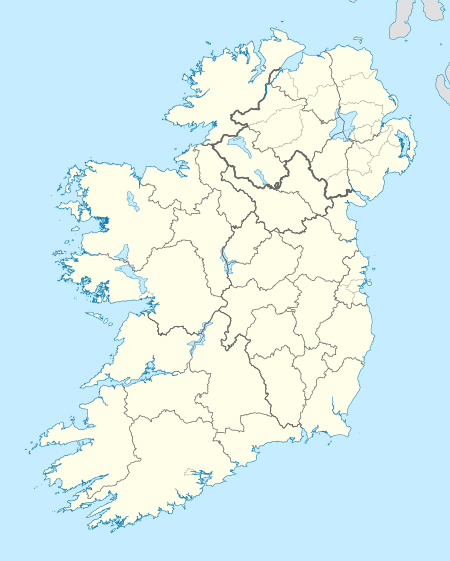Clarkstown radio transmitter
|
The Clarkstown site | |
 Clarkstown Location in Ireland | |
| Location | Clarkstown, County Meath |
|---|---|
| Mast height | 248 metres (814 ft) |
| Coordinates | 53°27′46″N 6°40′39″W / 53.462649°N 6.677589°WCoordinates: 53°27′46″N 6°40′39″W / 53.462649°N 6.677589°W |
| Built | 1988 |
The Clarkstown radio transmitter is a longwave radio transmitter in County Meath, Ireland. It is located some 3.5 km east of the village of Summerhill, in a field south of the R156 regional road at Clarkstown.
Constructed in 1988 for the transmission of Atlantic 252 on 252 kHz, it uses one 248-metre-high guyed steel framework mast with triangular cross section, insulated against ground. The original transmitters were two 300 kilowatt Continental Solid State transmitters built by Varian Associates of Dallas. These were replaced in 2007 by a single 300 kilowatt Transradio TRAM 300L transmitter.[1] The ground around the mast and the entire transmission site bed are lined with copper for conductivity. The site has an ITU-cleared transmission power of 500 kW by day and 100 kW at night but is now only capable of operating at 300 kW by day and 100 KW at night.
Atlantic 252 ceased operations on 20 December 2001 and the transmitter was later taken over by RTÉ Networks Limited (now 2RN). It is now used for the AM version of RTÉ Radio 1 on 252 kHz, and has been the sole source of RTÉ Radio 1 on AM since 24 March 2008, when the medium wave Tullamore transmitter on 567 kHz was taken off air.[2]
In 2007, the transmitter was carrying a Digital Radio Mondiale multiplex overnight, featuring Radio 1, RTÉ Digital Radio Sport, RTÉ Digital Radio News and the World Radio Network, before reverting to AM transmission for the daytime. DRM tests have since ceased, and AM transmissions now operate full-time once again.
On September 24th 2014, RTÉ announced that broadcasting of RTÉ Radio 1 on 252 kHz will cease on October 27th, 2014.[3] Following representations from Irish listeners in the UK and others that date has now been postponed until beyond January, 2017.[4]
Timeline
- 1988 - Construction of Clarkstown Transmitter by Radio Tara (RTÉ/RTL)
- 1989 - Launch of Atlantic 252 on September 1st, 1989, pop station aimed at UK and Irish market
- 2001 - Closure of Atlantic 252, December 20th, 2001
- 2002 - Launch of TEAMtalk 252 aimed at UK and Irish market
- 2002 - TEAMtalk 252 ceased broadcasting on June 30, 2002
- 2002 - RTÉ take over the running of the Clarkstown Transmitter following demise of TEAMtalk
- 2004 - Official launch of RTÉ Radio 1 on Long Wave 252, January 2004
- 2004 - While the Tullamore transmitter was offline for maintenance Clarkstown provided Radio 1's AM service
- 2007 - Major upgrade of Transmitter
- 2007 - RTÉ run DRM tests, in parallel with Analogue AM service
- 2008 - 24th of March, Closure of RTÉ Medium Wave service leaving 252 Long Wave as the only AM Broadcast by RTÉ, services which were on Medium Wave transferred to Long Wave.
- 2008 - December 1st, launch of RTÉ Radio 1 Extra which was extra content not broadcast on FM was now relayed on Long Wave 252
- 2014 - RTÉ announce plans to close Long Wave 252, September 2014
- 2014 - RTÉ announce postponement of closure plans until 2017
Gallery
-

Close up of the mast
-
Wider shot of the mast
-
Guy lines stabilizing the mast
-

The site entrance
See also
References
- ↑ DRM Long Wave Transmitter in Summerhill (Ireland)
- ↑ Noonan, Laura (2008-01-19). "Anger as RTÉ to switch off medium wave band". Irish Independent. Retrieved 2010-12-18.
- ↑ http://www.rte.ie/about/en/press-office/press-releases/2014/0923/645685-rte-radio-1-moves-from-longwave-transmission/
- ↑ http://www.rte.ie/news/2014/1219/667931-rte-longwave/
External links
- http://tx.mb21.co.uk/features/252/summerhill.shtml – pictures from mb21
- Summerhill Transmitter at Structurae
- http://www.skyscraperpage.com/diagrams/?b45496
- IAA information on the mast here (page 20).
- http://members.lycos.co.uk/gregsradio/newpage0.html